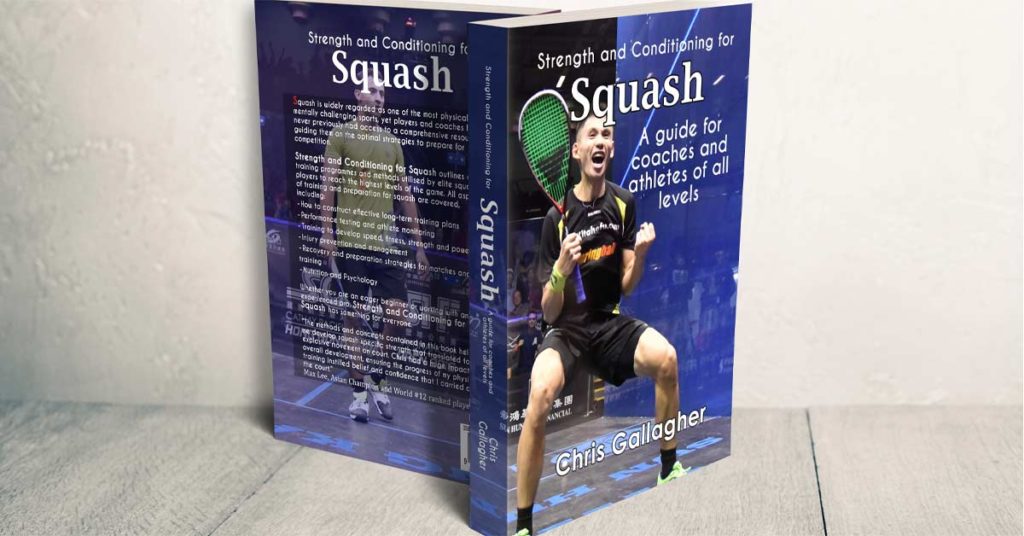
Squash match play can be fast and frenetic, characterised by many short, sharp explosive movements, accelerations, decelerations and changes of direction. Contemporary stars such as Mohamed El Shorbagy, Paul Coll and Miguel Rodríguez can be seen darting around the court, sprinting from corner to corner to pick up a drop shot or leaping sideways across the T to take an early volley. The high intensity, explosive moments usually determine the outcome of key points and the momentum and result of the match. Speed and agility are clearly vital attributes determining success in squash, and this importance should be reflected in the structure and detail of your training programme.
The biggest error that athletes and coaches make in training speed and agility is a lack of rest and a consequent lack of intensity and quality, says @Coach_ChrisG. Share on XThe biggest error that athletes and coaches make in training speed and agility is a lack of rest and a consequent lack of intensity and quality. If your goal is to develop speed and agility, then the repetitions need to be high quality, explosive efforts with long rest periods. Sprints need to be as close to maximal as possible. For speed development it is a case of quality over quantity. It may sound obvious, but a popular coaching expression is:
-
“To be fast you have to run fast!”
This phrase concisely explains the need for high quality, high intensity efforts with sufficient rest; positioned during your weekly and daily training programme when you are fresh and ready to be explosive. When a player is clearly fatigued and there is a breakdown in technical competence that should signal the end of the rep, set or exercise rather than blindly adhering to the number pre-determined on the programme.
There is, of course, some interplay between the different physical and physiological attributes required for successful squash performance. For example, training for speed is complemented by strength and power training, plyometrics, flexibility and mobility. These attributes are addressed in their own chapters within this book. Whilst it may be tempting to think of speed and agility as combined abilities, one does not necessarily translate directly to the other, and it is more appropriate to consider each quality in isolation.
Speed
The best place to look for strategies to develop speed, or at the very least guide you in the right direction, is with the experts from athletics. No one knows more about harnessing and improving straight line sprinting speed than track athletes and coaches. Whilst squash athletes are not 100m sprinters, nor will they ever get close to covering anywhere near that distance in a straight-line sprint on court (the maximal sprint would be under 10m), building your technical and physical training model from knowledge extrapolated from these experts is the ideal foundation. Whilst it is acknowledged that straight line speed must be translated into more sport specific movements, observing the training methods of a track sprinter can teach the court-based athlete a lot about violent intent of movement, explosiveness, application of forces and body angles.
-
“Intent is every bit as important as one’s movement quality…
…One must move boldly and with a ‘violent grace.’”
–Brett Bartholomew, Strength & Conditioning Coach and founder of Art of Coaching
If you want evidence of the need for speed in squash, go to YouTube and search for “outrageous dive & winner – best retrieval ever”! Speed, and sprint training, is important in most sports, not just athletics, yet many athletes never learn correct sprinting technique. The website squashskills.com provides a strong recommendation for the importance of speed training for squash players: “Speed training is all about quality over quantity – so short, sharp efforts interspersed with longer recovery periods. As your speed improves, think about trying to not just use your speed to retrieve the ball and defend, but to actually use your speed to apply pressure and attack by getting onto your shots that bit earlier”.
Speed is a global term that may represent several related, but individually distinct, abilities. Conceptually, speed can be considered to consist of the following elements:
- Acceleration – The rate at which an athlete can increase speed to maximal levels.
- Max Velocity – The maximal speed an athlete can attain.
- Speed Endurance – The ability to sustain maximal or near-maximal velocity.
The phase of greatest interest to a squash player is acceleration; the ability to move from stationary to achieving the highest speed in the shortest time possible. The majority of movements in squash involve only 2 or 3 steps, and the ability to initiate and execute these movements as quickly and explosively as possible can be the difference between winning and losing a point, a game and ultimately a match. A squash player may never sprint in excess of 10 metres on court, but it is common practice across many sports to train athletes to move quickly over distances greater than that which they will perform in competition. For example, football (soccer) and rugby players may sprint over 30 or 40 metres in training even though most sprints in a match are typically 10-20m or less. There are two major reasons for this:
- If you only prepare for the average demands of your sport you are under-prepared for the most demanding passages of play. These are usually the critical moments in a match!
- Optimal development of acceleration and speed demands that training occurs over more than the 5m, 10m or 20m an athlete typically sprints over in their sport.
In trained athletes, acceleration occurs for 30-40m – even farther in elite sprinters. If you only practise moving quickly over 3 or 4 steps, you will fail to realise the full benefits of your speed and acceleration training. Therefore, it may be beneficial if a certain proportion of a squash player’s speed training is completed over distances in excess of 5-10m. Remember that your strength and conditioning work aims to enhance physical qualities above those of your typical squash training and match play. You are not trying to merely replicate the demands of the sport. The aim is to distort the game; to develop physical qualities above and beyond the demands of match play. If your capacity exceeds the demands of the sport, each point, rally or movement challenging that quality will be at a relative lower intensity.
Through understanding table 4.1, it becomes apparent that essential to effective sprint performance is the ability to apply the greatest force in the right direction in the shortest amount of time (whilst maintaining a smaller mass – speed is dependent on force relative to mass, highlighting the importance of body composition). Analysis of elite sprinters reveals that “faster top running speeds are achieved with greater ground forces not more rapid leg movements”. (Keep this in mind when speed and agility ladders are discussed later in this chapter!) It is the force applied to the floor and not the movement of the swing leg that differentiates elite level sprinters from slower counterparts. How the swing leg moves in recovery is largely dictated by what happens when your foot is on the ground. This knowledge should influence how squash athletes train for speed.
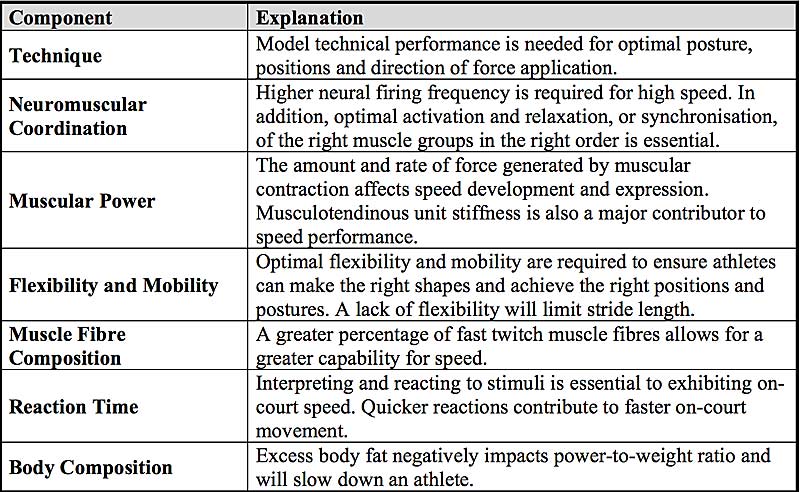
Normative data outlining performance standards for squash are not readily available, and so generic athletic standards or standards for other racket sports may provide a benchmark until such time as squash standards are published or you have collated your own data. It is useful to note that national governing bodies in tennis outline standards for 5m, 10m and 20m sprints for all age groups and across both sexes (refer to the Performance Testing and Athlete Monitoring chapter). Whilst tennis is contested over a larger court with larger sprint distances covered, it can reasonably be assumed that at least 5m and 10m sprint times would be appropriate performance indicators for squash.
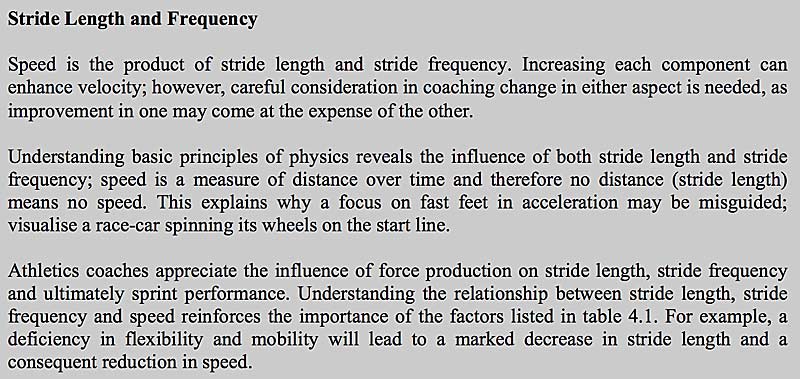
Reaction Speed and Anticipation
Reaction time describes the interval between the emergence of a stimulus and the initiation of a response. It is not enough for a player to be physically quick; they must also recognise and respond appropriately to stimuli on court such as the movement and sound of the ball and the movement of an opponent’s body and racket. A major determinant of the transfer of speed and agility training to the court is the specificity of the stimuli used. The more specific the stimulus, the greater the transfer, and this is particularly important for the mental processing components. Players accumulate a large amount of time on court reacting to the most sports specific stimuli, and the abilities of reaction time and anticipation are best developed in squash specific drills. In speed and agility sessions, players are often responding to whistles, cones, verbal commands and signals reducing the specificity of these drills.
There is a compelling argument that strength and conditioning sessions are best devoted to developing physical qualities which enhance speed, says @Coach_ChrisG. Share on XTherefore, there is a compelling argument that strength and conditioning sessions are best devoted to developing physical qualities which enhance speed. On-court sessions, under the guidance of the squash coach, may provide the most appropriate environment for developing sport specific skills of anticipation and reaction time. This can be complemented by maximal sprint training in strength and conditioning sessions. The concept of “give them what the sport doesn’t” is discussed in greater detail in the Coaching Philosophy and Guiding Principles section towards the end of this book. Speed training may still involve a certain amount of reactive ability such as responding to the coach’s command or in reaction to an opponent in a drill, but the emphasis should be on powerful and efficient movement mechanics.
Speed Reserve
As previously discussed, sprinting over greater distances in training can be beneficial to athletes who typically sprint over shorter durations in competition. Inclusion of longer sprints can benefit acceleration and other aspects of squash performance.
-
“Even though the confines of a court only allow them to sprint 5-8m at most, the benefits of sprints out to 30m in training can transfer significantly for these types of athletes in the form of CNS training, improving elasticity and overall general strength and speed benefits.”
–Derek Hansen, highly respected Canadian Strength & Conditioning Specialist
Athletes with a greater maximum velocity typically have a greater rate of change of velocity, more commonly known as acceleration. Athletes with a higher top speed accelerate faster and so reach higher velocities earlier in a sprint.
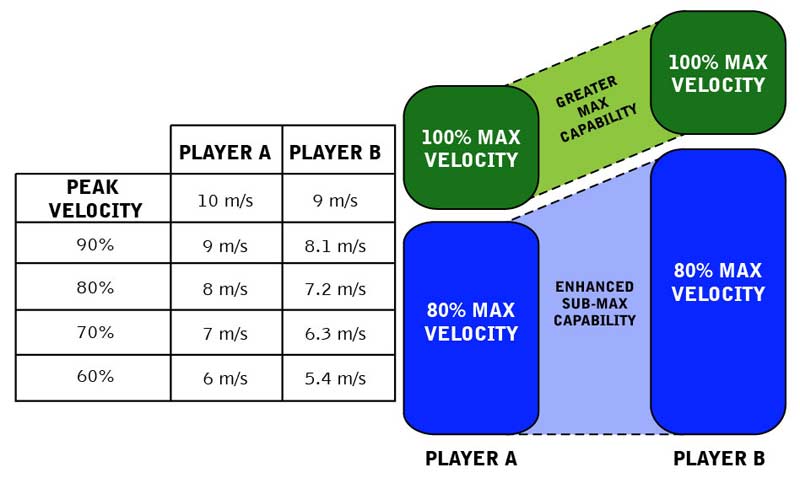
For a player with greater top speed, a submaximal sprint at any given speed is achieved at a lower cost relative to a slower opponent (figure 4.1). To illustrate this in simple terms, if an athlete has a maximum velocity of 9 m/s and they have to complete a number of 9 m/s sprints, then these efforts will be relatively more demanding (100%) for that athlete than another athlete with a maximum velocity of 10 m/s (90%). Having a greater potential for speed and acceleration means the sprints performed in a match are at a relatively lower cost to the athlete, facilitating greater energy conservation and efficiency.
Whilst many coaches understandably prioritise agility training over straight line speed, the value of squash specific practice to the development of squash specific movement skills should not be overlooked. With players on court four or five days a week, the volume of sport specific movements performed is very high, and this should be factored into the overall training plan. The recommendation is not for speed training to take precedence over agility. Instead, development of linear speed should be viewed as complementary to sport-specific movement skills.
The remaining bio-motor ability relating to speed, speed-endurance, has little value in squash. Speed endurance refers to the ability to maintain velocity at or close to maximum, occurring only once maximum velocity has been achieved. As squash players do not have the time or distance to create maximal running speeds, they have no need for being able to sustain or to train and develop speed endurance. This should not be confused with repeated sprint ability, which is the ability to perform several high intensity efforts, often with short or incomplete recovery.
Repeated Sprint Ability

-
“An athlete who has exceptional maximal sprint capabilities can still operate at very high speeds during a match or game and not fatigue, since most sports operate at much slower speeds as proven by GPS technology. Thus, an athlete that is well trained from a sprinting perspective will always demonstrate exceptional RSA throughout practice or competition.”
–Derek Hansen, highly respected Canadian Strength & Conditioning Specialist
Comparisons of the different levels in the National Squash programme in England, from talented juniors right through to established world tour players, led researchers to identify RSA and lower body explosive capabilities as key physical performance indicators for elite squash performance. (Reactive strength and lower body explosive power determine change of direction speed and thus influence RSA.) Whilst these “sprints” or high intensity efforts do not exactly resemble the image of Usain Bolt striding down the track, successful squash performance is linked to the ability to repeatedly produce fast, powerful, high intensity efforts interspersed with periods of lower intensity activity.
RSA can actually be a more complex metric than it may initially appear with a combination of neural and metabolic factors affecting performance, says @Coach_ChrisG. Share on XRSA can actually be a more complex metric than it may initially appear with a combination of neural and metabolic factors affecting performance. Inherent to RSA are: the ability to perform a fast sprint, the ability to repeat close to maximal sprint ability again and again with minimal increases in time and the ability to do this with incomplete or short recovery.
To assess RSA, sports scientists will measure:
- Best Sprint time
- Total Sprint time (aggregated time of all sprints)
- Average Sprint time
- Worst Sprint time
- Fatigue Index (FI – the decline in performance from the best to worst sprint)
- Sprint Decrement (Sdec – comparing actual performance to an idealised performance where the best effort would be reproduced in each sprint)
Analysis of one or two of these measurements alone can give an inaccurate assessment of an athlete’s RSA. For example, an athlete who does not slow down much from the first sprint to the last will have a good fatigue index, sprint decrement and apparently a good RSA. But if their initial sprint speed is slow then they do not demonstrate effective RSA, and an athlete with higher fatigue index and sprint decrement but a faster best sprint time may in fact demonstrate superior RSA. A higher sprint decrement score does not always indicate a poorer RSA; greater RSA is demonstrated by superior average sprint performance, with or without a low fatigue index.
A higher sprint decrement score does not always indicate a poorer RSA; greater RSA is demonstrated by superior average sprint performance, with or without a low fatigue index, says @Coach_ChrisG. Share on X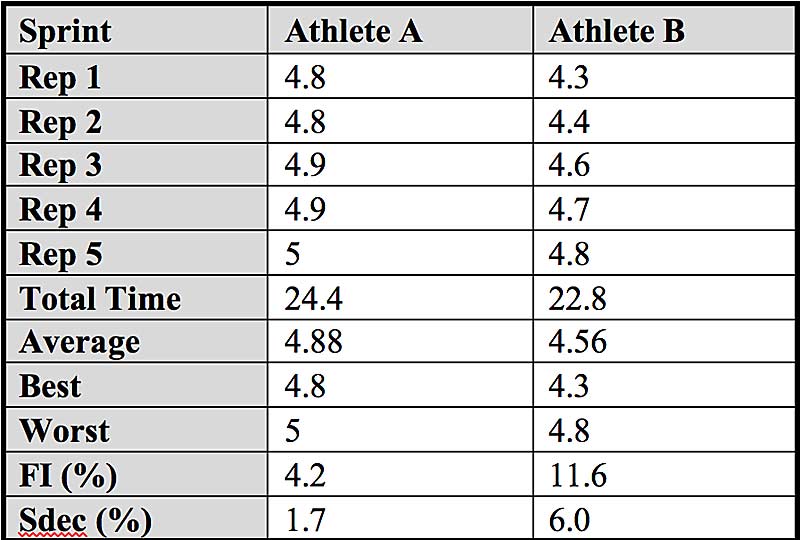
-
“Repeat speed qualities start with the ability to produce speed first…
…the decay of output is usually not as important.”
– Carl Valle, USATF II Coach, Sports Tech & Performance Analysis Consultant
When training to improve RSA, two primary training theories have been proposed:
- According to the principle of training specificity, the best way to train RSA is to perform repeated sprints.
- Employ training interventions that target the main factors limiting RSA.
Research indicates that maximising RSA is linked to improving single-sprint performance. In addition, the ability to excel in an RSA sport is dependent upon the aerobic capability of the athlete. Furthermore, extensive review of the available research suggests there is not one type of training that can be recommended to best improve RSA and concludes:
-
“1. It is important to include some training to improve single-sprint performance. This should include (i) specific sprint training; (ii) strength/power training; and (iii) occasional high-intensity (>VO2max) training (e.g., repeated, 30-second, all-out efforts separated by ~10 minutes of recovery) to increase the anaerobic capacity.
2. It is also important to include some interval training to best improve the ability to recover between sprints (if the goal is to improve fatigue resistance). High-intensity (80-90% VO2max) interval training, interspersed with rest periods (e.g., 1 minute) that are shorter than the work periods (e.g., 2 minutes) is efficient at improving the ability to recover between sprints by increasing aerobic fitness (VO2max and the lactate threshold), the rate of phosphocreatine re-synthesis and intracellular buffering (the removal of H+ build up).”
(Bishop et al 2011)
General recommendations for improving RSA are as follows: squash players should train to develop maximal qualities in speed, agility, strength and power. When maximal capacity is high, any given submaximal effort will be relatively less demanding for the athlete. These maximal capacities should be supported by aerobic interval training and more specific RSA efforts and incorporate sports specific movements.
Examples of different repeated-sprint ability training sessions include:
- 10 x 20m sprints with walk back recovery
- 10 x 6-10s cycle sprint w/ 30s recovery
- 10 x 6-10s cycle sprint w/ 3min recovery. The different recovery protocols between ii and iii produce very different physiological responses. (ii assists in maintaining power output across each subsequent sprint effort in training and matches. iii enhances maximal power output).
- 8-10 x 10-15s or specified number of shots ghosting w/ 30s recovery.
As RSA training can be highly fatiguing, and when inappropriately prescribed may lead to a decrement in RSA performance, this kind of training should be implemented at a lower frequency within the overall training plan. Research investigating the influence of ‘traditional’ sprint training on RSA is lacking, with many sports scientists believing such training may produce greater improvements in both best sprint time and mean sprint time. Therefore, specialised RSA training may be unnecessary.
The preceding article is excerpted from Chris Gallagher’s book Strength and Conditioning for Squash, which you can find here.
Since you’re here…
…we have a small favor to ask. More people are reading SimpliFaster than ever, and each week we bring you compelling content from coaches, sport scientists, and physiotherapists who are devoted to building better athletes. Please take a moment to share the articles on social media, engage the authors with questions and comments below, and link to articles when appropriate if you have a blog or participate on forums of related topics. — SF


The book can be purchased here:
https://www.amazon.com/dp/1527289621
Loved this article, Chris. I would like to have the signed copy from you very soon :p